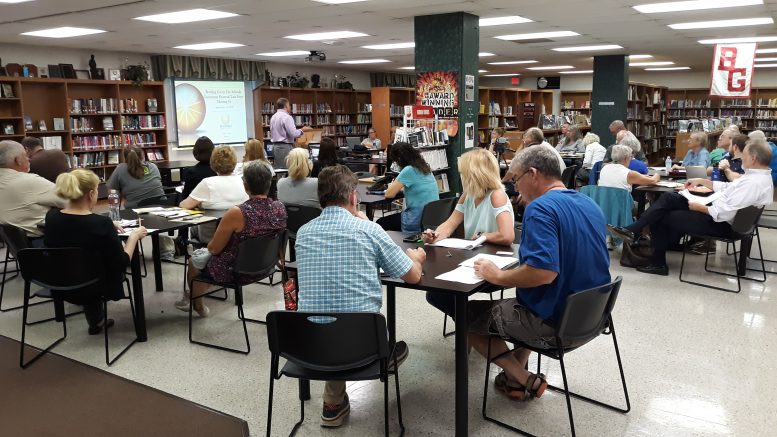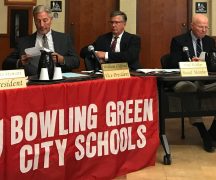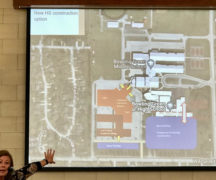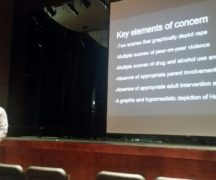By JAN LARSON McLAUGHLIN
BG Independent News
More than 50 citizens went back to school Wednesday evening to brush up on their math skills – specifically how the Bowling Green City School District can pay for building improvements.
This first meeting – like all that consultant David Conley will hold – was an “open mic night.” The citizens on the task force rattled off questions they want answered as they dig into financing the school district’s future. Such as:
- What’s the difference between income and property taxes?
- What public-private partnerships are available to fund school projects, such as naming rights for private businesses?
- What legislation is in the works that could make a difference for BG schools?
- Are there public-public partnerships that could help BG schools, such as with Bowling Green State University, the city, the public library or through public health?
- Can different types of taxes be combined for projects?
The monthly meetings of the financial task force are intended to give citizens the building blocks to help them make a decision that can then be presented to the school board.
Conley explained some of the basics, such as – financing tools are the instruments used to borrow money. A funding plan is how the district can pay off that financing for a building project.
“Schools only have a few financing tools available to them,” Conley said. But the funding options are far more plentiful, he added.
“I want to give every opportunity a chance,” he said. That includes exploring the use of an income tax put on by the city but used to pay for school buildings. Or the sale of properties owned by the school district that are no longer occupied by buildings.
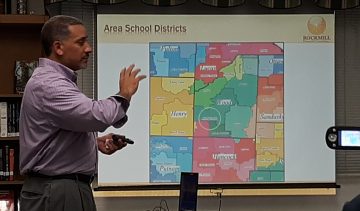
David Conley shows map outlining area school districts.
Conley, of Rockmill Financial Consulting, has worked with about 125 school districts in Ohio to find funding solutions. He stressed to task force members that they are in control.
“We’re in control of our own lives – especially when it comes to government. We just have forgotten that we are,” he said.
The district’s request for open minds fell on a few closed ears. A handful of the citizens vehemently opposed to the last two bond issues talked about the district being deceptive in its use of permanent improvement dollars to put an addition on the middle school.
Conley pointed out that permanent improvement funds can be used for projects like a building addition without going back to the voters.
Some of the questions went further than just dollars and cents. One person asked if it would be possible to change the district boundaries, so that those areas outside the city can become part of another district, perhaps joining Patrick Henry or McComb.
Another asked if the task force members will learn about demographics – what will sell and how they can sell it to voters.
Yes, Conley said. “You will know how to look your neighbor in the face and say ‘We did our best.’”
Conley cautioned that while the information about the district is “a snapshot of who you are today,” the task force’s decisions will have a lifespan of 30 to 50 years.
“We’re making decisions not just about right now,” he said. These decisions will affect the citizens’ grandchildren and great-grandchildren.
“We want to create the best possible options” for today and decades from now, Conley said.
Conley presented some basic facts about the school district:
- The district is 150 square miles. “Holy cow,” he said. That’s about twice the size of the city of Toledo, and bigger than Philadelphia which is about 135 square miles. “This is a gigantic school district.”
- While the city of Bowling Green is the most populous entity in the district, there are also 12 other townships or villages in the district.
- The district has 3,021 students, which makes it the ninth largest district in the area by enrollment, and the second largest in Wood County after Perrysburg.
- The district has five school buildings. All are paid off except the middle school.
- The district’s tax base is the second largest in Wood County at $667,277,270. The first largest is Perrysburg at $927,809,630. The other districts in the county are all below $370,000,000.
- The district ranks 101st out of the 612 school districts in Ohio for tax base. That ranking is why Bowling Green is so low on the list of districts that can receive state funding for school building construction.
Conley also talked about the realities versus perceptions about taxes. He showed a chart of taxes for area school districts in comparison to the median family income in those districts. Bowling Green is the fifth lowest of 16 area districts.
Those districts with higher tax burdens based on their residents’ incomes and home values include Eastwood, Toledo, Oregon, North Baltimore, Perrysburg, Washington Local, Maumee, Rossford, Springfield, Sylvania and Ottawa Hills. Those ranking lower than Bowling Green are Lake, Elmwood, Otsego and Northwood.
“I deal in reality, not perception,” Conley said.
Conley also showed charts of tax valuations. Those showed a big jump in agricultural land valuations.
“That is a huge increase in taxes,” he said. And that puts more burden on farmers because of Ohio’s system of funding schools. “It’s heavily weighted toward property taxes.”
However, home valuations saw a jump this year, he added.
Conley also mentioned the high percentage (31 percent) of the current bonds being paid for by local businesses.
“We’re starting better off than a lot of school districts by having 30 percent,” he said.
He also reminded residents that businesses don’t pay income taxes for schools – those are all on the citizens to support.
Conley explained that property taxes include exemptions for government, non-profits, churches, and businesses with abatements. Concerns were brought up about BGSU not paying property taxes.
“It’s a common long-standing exemption,” Conley said, noting the other benefits that BGSU brings to the community.
Conley noted his surprise at the percentage of renting residents in the school district.
“You have the record number of renters in the community,” he said. But he advised that renters do pay more when property taxes increase. “Renters pay taxes, they just don’t know they are.”
When looking at the election history of the school district, Conley found the voters have only passed two of five bond issues since 1987. However, the voters are much more supportive of operating levies – which are also important.
“You can have a building sitting out there, nice and pretty, but if you don’t have the money to operate them” the district is in trouble, he said.
The district’s voters have also shown strong support for income taxes for schools – which is notable, Conley said.
“After the recession, a lot of renewal levies either failed for barely passed,” but BG’s passed with big margins.
“You, as a community, like your schools, and I can tell,” he said. “This community cares a great deal about their schools.”
Conley showed another chart that indicated growing support over years of election history.
“This is a pretty remarkable trend line,” he said, pointing toward the upward trajectory of voter support.
At the end of the meeting, Conley presented a list of his conclusions about the district:
- Bowling Green is a relatively large school district in Ohio.
- It is comprised of many communities, not just the City of Bowling Green.
- All of the school buildings are paid for except the Middle School.
- Businesses are a major contributor to the tax revenues of the district.
- The district’s tax cost is moderate when compared to others in the region.
- The district’s tax base is very strong and is growing.
- While bond issues have had mixed election results, residents of the district have been highly supportive of operating levies.
- Community support has grown significantly over the past 20 years.
The next meeting of the financial task force will be Oct. 17, at 7 p.m., in the Bowling Green High School library. That meeting will focus on “how taxes work,” the demographics of the district, and comparisons to similar districts.

